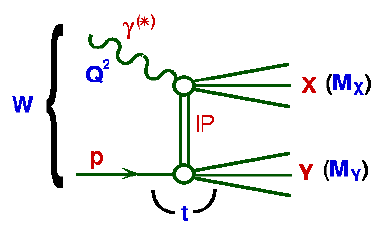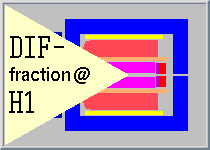Introduction
|
 In the H1 Diffraction Physics Working Group, ep collisions exhibiting
a large phase space area devoid of particle production in the region of
the outgoing proton ('rapidity gap events') are studied. This is
unlike "normal"
ep interactions, where the proton remnant and the
struck quark are thought to be connected by QCD colour fields, resulting
in a relatively homogeneous production of hadrons. Regge theory has since
long been able to describe the cross section for diffractive dissociation
as a function of centre-of-mass energy (W) and squared momentum
transfer (t) using the concept of reggeon and pomeron exchanges.
In the H1 Diffraction Physics Working Group, ep collisions exhibiting
a large phase space area devoid of particle production in the region of
the outgoing proton ('rapidity gap events') are studied. This is
unlike "normal"
ep interactions, where the proton remnant and the
struck quark are thought to be connected by QCD colour fields, resulting
in a relatively homogeneous production of hadrons. Regge theory has since
long been able to describe the cross section for diffractive dissociation
as a function of centre-of-mass energy (W) and squared momentum
transfer (t) using the concept of reggeon and pomeron exchanges.
The elastically scattered proton in Diffractive events can also be
directly measured using "roman pot" detectors (FPS) very close to the proton
beam far downstream of the interaction point. A new detector -
the VFPS -
has been installed in 2003.
|
In addition to the study of rapidity gap events, we measure cross sections
for events with high energy forward proton or neutron production ('leading
baryons'), we study the exclusive production of light vector mesons
and photons ('Deeply Virtual Compton Scattering - DVCS') - see
here, and
we search for the Odderon. Note that heavy vector meson production
(J/Psi and Upsilon) is studied in the H1 Heavy Quark Group.
The novelty at HERA lies in the fact that these processes can be studied
as function of several hard scales like photon virtuality(Q2),
squared momentum transfer (t) or quark mass, thus enabling perturbative
QCD calculations for (at least part of) the interaction mechanism. The
challenge in modern research of diffractive phenomena is therefore to reconcile
the concepts of Regge theory with a microscopic description in terms of
QCD. |



